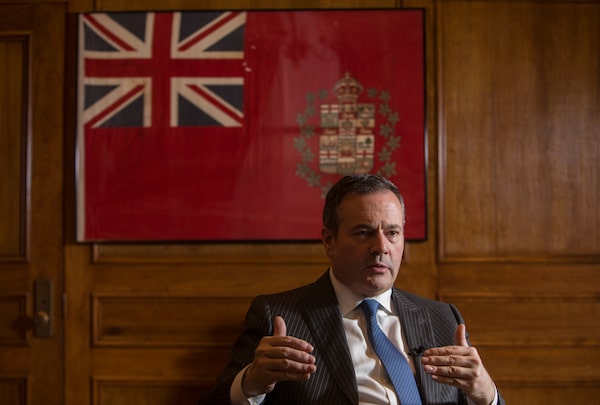
Alberta Premier Jason Kenney's decision to begin tying post-secondary funding to performance, has ignited the wrath of many.AMBER BRACKEN/The Canadian Press
There’s a pattern developing around many of the policy announcements being made by the Alberta government of Jason Kenney.
First, the course of action is made public. Then the Opposition and a swath of the populace react in outrage. There are the allegations of being blind-sided, of the United Conservative Party failing to be up front about the decision upsetting people. Then it’s revealed that the offending measure was, in fact, part of the party’s campaign platform.
Which brings us to the latest move by Mr. Kenney igniting the wrath of many: the decision to begin tying post-secondary funding to performance.
Those caught off guard were not paying attention. Not only was this a campaign pledge of the UCP, it was also highlighted as something that needed to be done in a report by former Saskatchewan finance minister Janice MacKinnon, released last September, that looked at ways the government could cut costs without damaging the economy. The government also indicated in its October budget it would tie future funding for post-secondary institutions to their responsiveness to “skills shortages and future labour market challenges.”
Is this a good thing? That remains to be seen.
The world of advanced education in Alberta was ripe for targeting; Like virtually every aspect of public spending in the province, outlays in post-secondary education were out of whack, especially when measured against the rest of the country. Over the last decade, spending in this sector had grown at an average of four per cent a year, while the post-secondary demographic (people 15-39) had grown by only 1.3 per cent.
Administration costs in this area were also grossly out of line – almost twice as much per full time student compared to provinces such as B.C. and Ontario. Meantime, Ms. MacKinnon found that nine of 26 post-secondary institutions in Alberta fell below an average completion rate of 60 per cent. One had a rate of 40 per cent.
The province’s low post-secondary participation rate was often explained away by pointing to the lure of high-paying jobs in the energy sector. However, the rate has continued to lag, despite the energy recession and lack of jobs in this field. So something’s not right.
Provincial funding has been made through block grants, with little regard to enrollment or program offerings. The accountability that might have existed, in regards to the dollars universities and colleges received, has disappeared over time.
Well, no more.
Mr. Kenney intends to bring some long-overdue discipline to the process. In future, funding will be tied to performance measures such as graduate employment rate, graduate skills and competencies, administration expense ratio, enrollment, sponsored research revenue and others. There are undoubtedly some schools already deeply nervous about the ramifications.
Once the system is up and running, the government will forge a link between block grants (which make up about 40 per cent of a post-secondary institution’s funding) and its performance metrics. If a school only meets 75 per cent of its targets, it will only get 75 per cent of the funding it might otherwise have been expecting. So there’s a lot riding on this.
Unsurprisingly, there are concerns about how this will all play out, and how external factors, over which post-secondary facilities have little to no control, might affect their performance scores. An obvious example would be the general state of the provincial economy.
Another deep recession such as the one Alberta is just climbing out of would invariably affect things like graduate employment rates. There could also be examples of self-fulfilling prophecies.
A school, say, that is struggling in some of its performance categories gets its funding cut. That funding cut means the school has to make up the revenue shortfall somehow, so it starts trimming corners. Those cost-saving measures, in turn, could make it even harder for the institution to meet its targets in future.
Schools will argue there are lots of factors that go into graduation rates, including the quality of the teachers. Better funded schools generally get better teachers. But that is a fact of life in the private sector too. So welcome to the real world.
It may be a few years before all the legitimate issues with this new system are addressed. But the Kenney government has made a move here that was long overdue.
Keep your Opinions sharp and informed. Get the Opinion newsletter. Sign up today.
 Gary Mason
Gary Mason